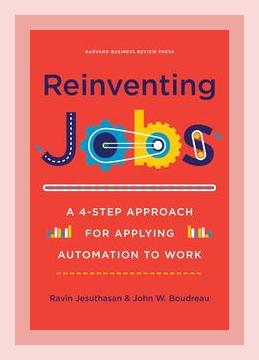Technology and Digital TransformationDigital Strategy
Title: Reinventing Jobs: A 4-Step Approach for Applying Automation to Work
Authors: Ravin Jesuthasan and John W. Boudreau
Publication Year: 2018
Category: Digital Strategy
Overview
“Reinventing Jobs: A 4-Step Approach for Applying Automation to Work” by Ravin Jesuthasan and John W. Boudreau presents a structured framework to navigate the complex interplay between automation and work. As modern organizations grapple with rapid technological advancements, the authors offer a practical, step-by-step methodology to strategically integrate automation, ensuring that both the workforce and business objectives are optimized.
Introduction
Automation and artificial intelligence (AI) are rapidly transforming the landscape of work. Transitioning from traditional roles to automated systems requires not merely the adoption of technology but a strategic approach that reimagines jobs around human and machine collaboration. Jesuthasan and Boudreau lay out a clear, four-step roadmap to guide this transformation.
Four-Step Approach
1. Deconstruct the Job
Major Point: Analyze jobs at a granular level to identify which tasks can be automated.
- Action: Break down each role into specific tasks to understand their nature and requirements.
- Example: Retail customer service roles can be broken down into tasks like answering inquiries, processing returns, and restocking shelves. Tasks like answering inquiries can be automated using chatbots.
Key Insight: Not all components of a job will or should be automated. Distilling roles into tasks helps pinpoint areas where automation can add value without diminishing human contribution.
2. Assess the Alternative Work Options
Major Point: Evaluate different types of automation and their impact on job tasks.
- Action: Examine various technologies, such as AI, robotics, or machine learning, to see how they align with different tasks.
- Example: In financial services, audit tasks can be evaluated for automation using machine learning algorithms that analyze transactional data, reducing human error.
Key Insight: Technological solutions are not one-size-fits-all. Each type of automation offers different strengths and should be matched to tasks they can optimize.
3. Optimize Work
Major Point: Design the optimal combination of human skills and automation.
- Action: Create workflows that leverage both human and machine strengths in the most effective manner.
- Example: In healthcare, diagnostic processes can be optimized by having AI perform initial scans, which radiologists then review, ensuring a blend of speed and expert judgment.
Key Insight: The synergy of human and machine capabilities leads to greater efficiency and improved outcomes. This step involves re-assigning tasks or redesigning jobs to harness this synergy fully.
4. Reconfigure Work
Major Point: Continuously adapt work configurations to evolving technology and business needs.
- Action: Establish mechanisms for ongoing assessment and adjustment of work processes as technology and organizational goals evolve.
- Example: In logistics, companies can continuously monitor and tweak delivery routes and schedules, using AI-powered platforms to improve efficiency and reduce costs.
Key Insight: The integration of automation into work is an ongoing, dynamic process. Regularly reassessing both the technological capabilities and the evolving nature of tasks ensures sustained optimization.
Integration and Implementation
Major Point: Successful integration of automation requires meticulous planning and stakeholder engagement.
- Action: Develop a comprehensive change management plan that includes training programs, communication strategies, and feedback loops.
- Example: An insurance company implementing AI-driven customer service should provide extensive training to customer service representatives on how to use these tools effectively and gather their feedback to fine-tune the system.
Key Insight: Technology alone cannot drive change. Effective implementation hinges on how well an organization prepares its workforce and adapts its culture to embrace new tools.
Organizational Strategy and Culture
Major Point: Align automation initiatives with broader organizational strategy and culture.
- Action: Ensure that automation efforts reflect and support the company’s strategic goals and values.
- Example: A company prioritizing customer-centricity should focus on automating backend processes to free up employees to deliver better front-line customer service.
Key Insight: Automation should not be pursued in isolation but as part of a cohesive strategy that reinforces the organization’s overall mission and values.
Case Studies and Examples
Throughout the book, Jesuthasan and Boudreau provide numerous real-world examples to illustrate their points:
- Amazon: The company uses a blend of robots and humans in its warehouses. Robots handle heavy lifting and repetitive tasks, while humans manage quality control and complex decision-making tasks.
- DBS Bank: This Bank uses AI for customer service inquiries, enabling more straightforward questions to be addressed quickly by machines, while human agents handle escalated issues requiring empathy and complex problem-solving.
- Telstra: An Australian telecom company employs AI to monitor network performance and predict outages, allowing human engineers to focus on more strategic initiatives.
Ethics and Human Impact
Major Point: Address the ethical implications of automation and its impact on employees.
- Action: Implement fair transition strategies, including upskilling and redeployment, to mitigate negative impacts on jobs.
- Example: A manufacturing firm introducing robots on the assembly line can offer training programs for workers to transition into roles in robot maintenance or other emerging areas within the company.
Key Insight: Ethical considerations are crucial. Companies must balance business benefits with the social responsibility of supporting their workforce through transitions prompted by automation.
Conclusion
Reinventing Jobs emphasizes that the future of work lies in the strategic combination of human skills and automation. By meticulously deconstructing jobs, evaluating alternatives, optimizing human-machine collaboration, and continuously reconfiguring work processes, organizations can harness the full potential of technological advancements. The actionable insights and numerous examples provided by Jesuthasan and Boudreau equip leaders with the tools to effectively navigate and thrive in an increasingly automated landscape.
Incorporating thoughtful planning, ongoing adaptation, and ethical considerations ensures that both businesses and their workforces can benefit from the transformative potential of automation.
